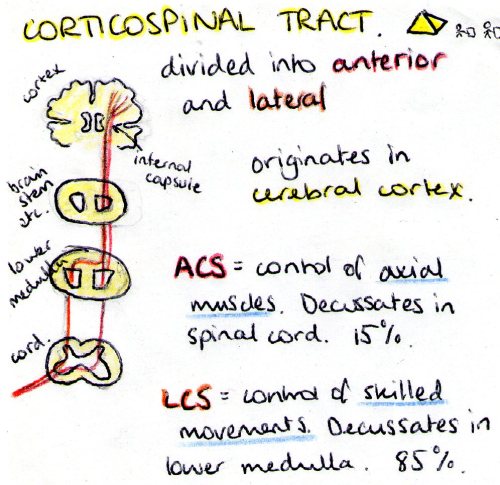#medical revision
Descending tracts in the spinal cord. Descending tracts are generally motor, and are divided into pyramidal tracts (cotricospinal and corticobulbar - i.e. the voluntary ones) and extra-pyramidal (all the others).
Corticospinal tract: carries motor fibres. Has an anterior (15%) and a lateral (85%) branch. Anterior controls the axial muscles while the lateral controlslimbs and skilled movements. They decussate in slightly different places, with the LCS crossing in the lower medullary pyramids, and the ACS at the spinal level they exit through.
Corticobulbar: not seen on this diagram because it doesn’t actually make it into the spinal cord. It terminates on cranial nerve motor nuclei to deal with motor functions of cranial nerves: facial expression, extra-ocular, etc.
Vestibulospinal: controls balance. It is special because it remains ipsilateral. Someone with a lesion of the vestibulospinal tract will fall (due to loss of balance control) towards the side of the lesion.
Reticulospinal: deals with reflexes. Has two branches, the pontine branch does extensor reflexes exclusively, while the medullary does both extensor and flexor. It also stays ipsilateral.
Tectospinal: another reflex type tract, that responds to visual and auditory stimuli. It is the reason that blind people can sometimes turn their head towards a flashing light without seeing it, but sensing it. Spooky.
Rubrospinal: bit vestigial in humans to be honest, most of its functions have been superseded by the corticospinal tract with which it joins in the lateral column of the spinal cord.
Post link
Believe it or not, if you google “pandas” this disease does in fact make an appearance on the first page. Didn’t the consultant feel silly though when he typed it in and the first thing that appears is all these pictures of pandas.
It’s a bit obscure, but it is the abrupt onset (or sudden dramatic worsening) of OCD and/or Tourette like syndromes following infection with group A beta haemolytic strep - such as with strep throat and scarlet fever. It is thought it might be an autoimmune response (“molecular mimicry” which is a term I have fondness for), similar to sequale of rheumatic fever (valve disease, chorea).
Mostly I felt like drawing a panda. I copied it from this guy.
Post link
More detailed post-it of the corticospinal tracts, showing the two tracts and their decussation.
Post link




